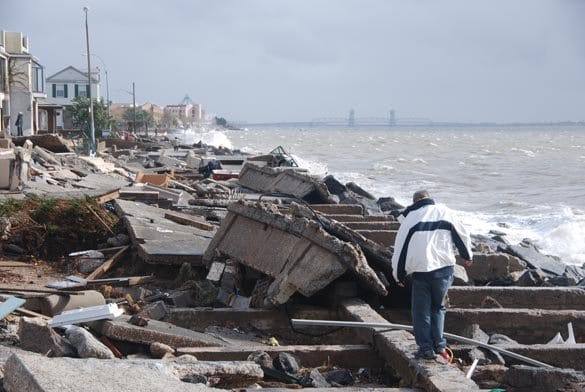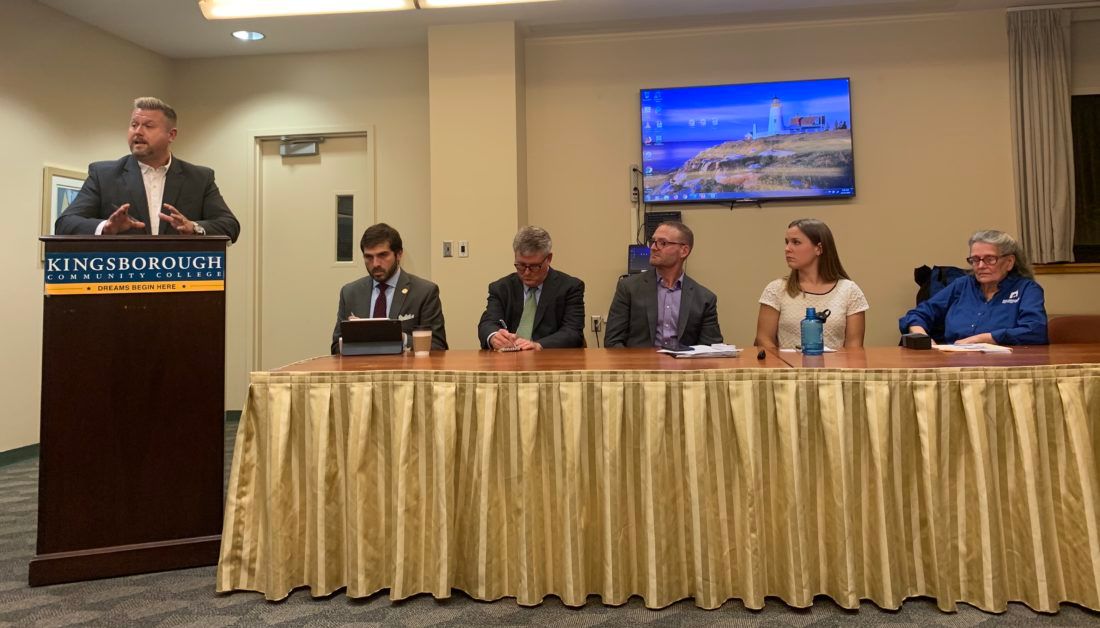Hurricane Sandy Anniversary Approaches to Remind How Perilously Unprotected Southern Brooklyn Remains

One week before the seventh anniversary of Hurricane Sandy, Senator Andrew Gounardes, and local and federal officials spoke about the inevitability of climate change at a town hall meeting on Climate and Resiliency at the Kingsborough Community College in Manhattan Beach.
About 80 residents gathered to listen and voice their concerns to the public officials, who had come to share how prepared southern Brooklyn is for another storm. They left disappointed with how little has been done to keep the rising waters out of southern Brooklyn. New York City is highly exposed to coastal risks like Sandy. With 520 miles of coastline – longer than the coastlines of Miami, Boston, Los Angeles, and San Francisco combined – New York City needs to exercise massive precautions against coastal flooding and storms.
Gounardes opened with an overview of the Climate Leadership and Community Protection Act, which passed earlier this year.
“[The Act] is the most ambitious environmental [and] climate change legislation in the country,” the senator said. The act is intended to put New York State on the path toward a net neutral carbon emissions economy by the year 2050, among other targets, “they’re not mandated goals, but our aspiration as a state is to get there,” he said.

The panelists spoke in blunt terms about the inevitability of climate change, avoiding platitudes and choosing instead to address the urgent risks posed to the New York City area from rising sea levels, coastal storms, and extreme temperatures.
John Miller of FEMA discussed mainly post-disaster mitigation programs operated by the agency in order to mitigate damage to public facilities in the wake of an environmental disaster. One of the post-disaster programs is the Hazard Mitigation Grant Program, this program would pay for projects like repairing erosion protection for the Marine Parkway Bridge, which connects Rockaway with Brooklyn. Another program is Public Assistance, which provides reimbursement for the repair of public facilities like bridges, roads, and schools in the wake of a natural disaster.
Land Use and Architectural Solutions
Eric Wilson, Deputy Director for Buildings and Land Use for the Office of Resiliency, took the stand next. “Our role in the office of resiliency is thinking about climate adaptation,” he said. “In other words, how to address the impacts of climate change that are already set in motion.”
The Office of Resiliency looks at the long-term effects of weather-related impacts due to climate change. Hurricane Sandy, he said, “was a huge wake-up call for us.”
Wilson spoke to areas in which the office is working to help make New York City buildings and infrastructure more responsive to future climate risks, such as a set of building guidelines for architects, engineers, and other designers.
The other panelists touched on areas such as flood insurance, zoning, and long-term housing recovery. Catherine Ferrara of the Department of City Planning’s Brooklyn office spoke making a more resilient built environment, such as changing zoning regulations to recognize the threats that flooding poses to homes and other structures. This would include ensuring that buildings are designed to withstand and recover from flooding. Since Hurricane Sandy, Ferrara said, the Department of City Planning has focused in particular on a resilient built environment. In 2013, shortly after Hurricane Sandy, they released a Flood Resistant Zoning Text that suspended zoning regulations which might have “presented obstacles to reconstructing buildings damaged by Hurricane Sandy to more flood-resilient standards.” Ferrara also pointed out area-specific projects, such as a proposal for Gerritsen Beach, that reflects current building density.
Flood Insurance: If a structure is not insurable, it’s not sustainable
Beth Malone, Program Manager for Resiliency and Insurance at Neighborhood Housing Services Brooklyn, provided updates to the National Flood Insurance Program. Malone underscored issues with the affordability of flood mitigation measures for homes.
“[Congress] has to do something about reauthorizing the National Flood Insurance Program,” Malone said, something they’ve neglected to do since 2012. She touched on topics like a new ratings system, Rating 2.0., which changes the way insurance costs are determined after disasters like Sandy. Factors like distance from the coast and cost to rebuild will affect a home’s individual rating.
Malone also spoke to the unique complications created by New York City’s built environment, particularly in coastal areas. “The built environment of coastal New York is physically and financially challenged,” she said. Additionally, she pointed out, if a structure is not insurable, it’s not sustainable.
“We’re going to reimagine, redesign, and rebuild New York City,” she said.
The final panelist was Andrew Olson, Senior Borough Director for the Mayor’s Office of Housing Recovery. Olson spoke to the long-term recovery process for residents in coastal communities. The focus, he said, is on what storm recovery will look like in the future.
“We can’t just be prepared and respond when a disaster happens,” he said. “We have to start the education process now.” Homeowners should know whether to elevate their utilities so they can remain in their homes when a storm hits, for example.
Water, Water, Everywhere
The meeting then opened up to audience questions. While the meeting drew roughly 80 people from almost every age group, it was the more senior locals who made themselves heard.
The first question was, “how do we keep the water out of Manhattan Beach?”
“We can build a sponge!” Malone joked.
“That was really appropriate,” scoffed one older woman seated near the front. “I don’t appreciate that answer.”
Continuing in her response, Malone said that the only solution to the problem would be to manage the water itself. “So you do have the solution?” the woman asked, pointedly.
The senator stepped in, informing the audience that the state had passed two pieces of legislation – one on studying a city sea wall, and one on studying rising sea levels affecting New York City, both of which are awaiting the governor’s signature.
Another question touched on the issue of sewage backup prevention. To this, Malone responded that the backflow valves that NY Rising wanted to install have run into complications because of antiquated sewers. “The funding for it is a mess,” she said.
Alan and Nancy Sacerdode had been attending the meetings since Hurricane Sandy. “It’s great that they’re having the meeting,” Alan said, “But it’s disappointing how little progress has been made.” One of the biggest questions she still has, Nancy said, was “when are we going to see something physically done?”



